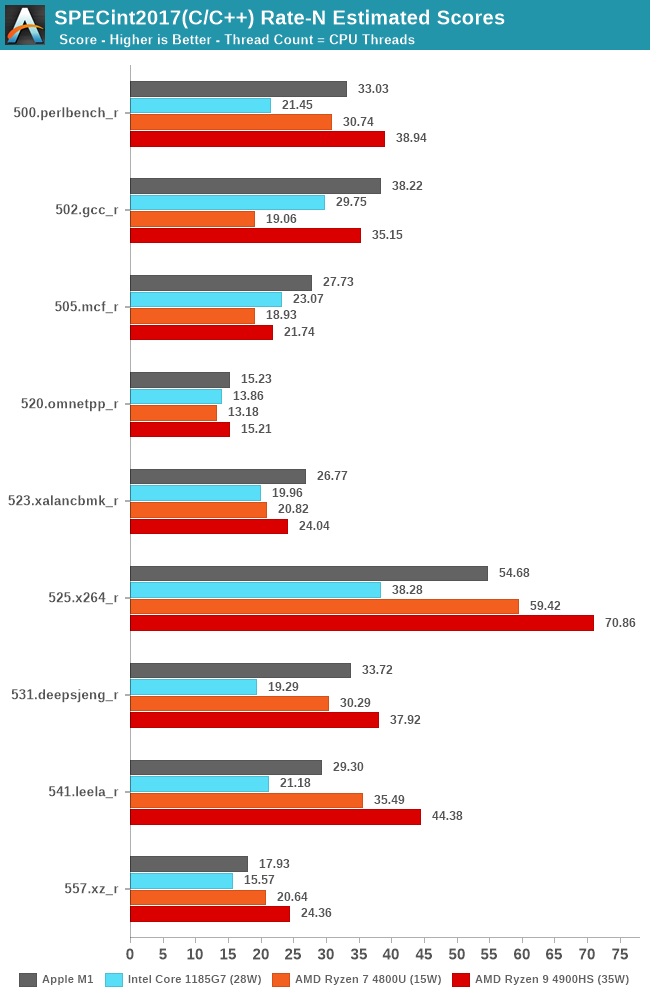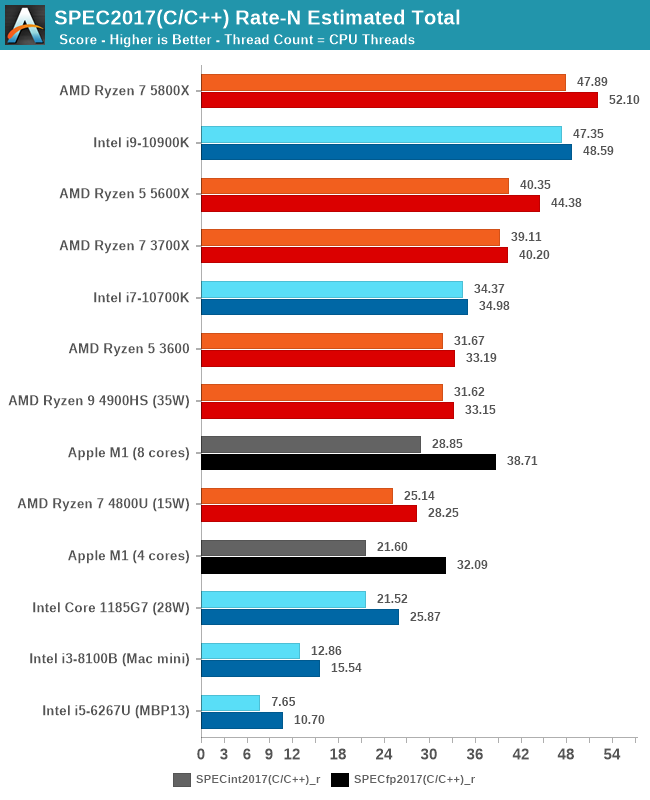The 2020 Mac Mini Unleashed: Putting Apple Silicon M1 To The Test
by Andrei Frumusanu on November 17, 2020 9:00 AM ESTSPEC2017 - Multi-Core Performance
While we knew that the Apple M1 would do extremely well in single-threaded performance, the design’s strengths are also in its power-efficiency which should directly translate to exceptionally good multi-threaded performance in power limited designs. We noted that although Apple doesn’t really publish any TDP figure, we estimate that the M1 here in the Mac mini behaves like a 20-24W TDP chip.
We’re including Intel’s newest Tiger Lake system with an i7-1185G7 at 28W, an AMD Ryzen 7 4800U at 15W, and a Ryzen 9 4900HS at 35W as comparison points. It’s to be noted that the actual power consumption of these devices should exceed that of their advertised TDPs, as it doesn’t account for DRAM or VRMs.

In SPECint2017 rate, the Apple M1 battles with AMD’s chipsets, with the results differing depending on the workload, sometimes winning, sometimes losing.

In the fp2017 rate results, we see similar results, with the Apple M1 battling it out with AMD’s higher-end laptop chip, able to beat the lower TDP part and clearly stay ahead of Intel’s design.

In the overall multi-core scores, the Apple M1 is extremely impressive. On integer workloads, it still seems that AMD’s more recent Renoir-based designs beat the M1 in performance, but only in the integer workloads and at a notably higher TDP and power consumption.
Apple’s lead against Intel’s Tiger Lake SoC at 28W here is indisputable, and shows the reason as to why Apple chose to abandon their long-term silicon partner of 15 years. The M1 not only beats the best Intel has to offer in this market-segment, but does so at less power.
I also included multi-threaded scores of the M1 when ignoring the 4 efficiency cores of the system. Here although it’s an “8-core” design, the heterogeneous nature of the CPUs means that performance is lop-sided towards the big cores. That doesn’t mean that the efficiency cores are absolutely weak: Using them still increases total throughput by 20-33%, depending on the workload, favouring compute-heavy tasks.
Overall, Apple doesn’t just deliver a viable silicon alternative to AMD and Intel, but actually something that’s well outperforms them both in absolute performance as well as power efficiency. Naturally, in higher power-level, higher-core count systems, the M1 can’t keep up to AMD and Intel designs, but that’s something Apple likely will want to address with subsequent designs in that category over the next 2 years.










682 Comments
View All Comments
tkSteveFOX - Friday, November 20, 2020 - link
Just imagine if they up the TDP to 40W on the next 3nm process next year?Perhaps the CPU part won't get big gains (let's face it, CPU is better than anything on the market up to 60W), but GPU should double the performance. By that time 95% of apps will be native as well, so M1 performance will gain another 10-20% additional performance in all scenarios.
mdriftmeyer - Saturday, November 21, 2020 - link
GPU double performance. That's delusional right there. Nothing in Apple's licensed IP will ever touch AMD GPU performance moving forward. Your claim the CPU is better than anything on the market up to 60W is also delusional.Enjoy 2021 when very little changes inside the M Series but AMD keeps moving forward. Being a NeXT/Apple alum I was hoping my former colleagues were wiser and moved to AMD three years ago and pushed back this ARM jump two more years.
ARM has reached its zenith in designs in the embedded space and that is the reason everything wowed is about Camera Lenses. Fab processes are reaching their zenith as well.
M1 is 12 years of ARM development by Apple's teams after buying PA Semi in 2008. It took 12 years with unlimited budgets to produce the M1. It's far less impressive than people realize.
Most of Apple's frameworks are already fully optimized after the past 8 years of in-house development. People keep thinking this code base is young. It's not. It's mature. We never released anything young back at NeXT or Apple Engineering. That hasn't change since I left. It's the mantra from day 1.
The architecture teams at AMD have decades more experience in CPU designs and nothing released here is something they haven't already worked on in-house.
Intel's arrogance is one of the greatest falls from the top in computing history. And it's only going to get worse for the next five years.
dontlistentome - Saturday, November 21, 2020 - link
Not sure when Intel will learn - they let the Gigahertz marketeers ruin them last time AMD had a lead, and this time it was the accountants. Wondering who screws them up again 15 years from now?corinthos - Monday, November 23, 2020 - link
Intel made so many mistakes and brought in outsiders who just didn't have the goods to set it on a good path forward. The board members who chose these folks are partially to blame. Larrabee was just one of the earlier warning signs.corinthos - Monday, November 23, 2020 - link
So are you saying that there's more limited growth opportunity for Apple going down the ARM path than people realize, and that the prospect of AMD producing competitive/superior low-powered processors is going to be much better?For now, it seems that for the power consumed, the M1 products have a leg up in power-performance over Intel or AMD-based competing products. Can Apple take that and scale it upwards to be competitive or even a leader in the desktop space?
I think about how there are some test results coming in already showing how a 2019 Mac Pro with a 10-core cpu and expensive discrete amd gpu and loads of ram being outshined by these M1's in some video editing workloads and wonder if a powerhouse desktop is such a good investment these days. That thing came out like a year ago and cost probably around $10K.
Focher - Tuesday, November 24, 2020 - link
From your post, I suspect you are not going to enjoy the next 2 years. Saying things like the code is already fully optimized is so ridiculous on its face, it’s hard to believe someone wrote it. If time led to full optimization, then what’s the magic time horizon where that happens? If you think Apple just played its full hand with the M1, you’ve never paid attention to Apple.blackcrayon - Tuesday, November 24, 2020 - link
I would think doubling GPU performance would be one of the easier updates they could make. More cores, more transistors with their existing design - the same thing they've done year after year to make "X" versions of their iPhone chips for the iPad. The M1 isn't at the point where doubling the GPU cores would make it gigantic and unsuitable for a higher end laptop or desktop. Unless you thought he meant "double Nvidia's best performance" or something which isn't going to be possible currently :)zodiacfml - Friday, November 20, 2020 - link
Coming back here just to leave a comment though the M1 truly leaves any previous Apple x86 product in the dust, it is far from the performance of a Ryzen 4800U which has TDP of 15W. The M1 is at 5nm while consuming 20-24W.The M1 iGPU is mighty though, which can only be equaled or beaten by next year/generation APU or Intel iGPU
thunng8 - Saturday, November 21, 2020 - link
The 4800u uses up to 50w running benchmarks and under load. You will never see a current gen Ryzen without active cooling. In laptops running benchmarks, the fans ramps up to 6000rpm while the m1 can run in the MacBook Air with no cooling with hardly any performance degradation. And there’s also the issue of battery life where the m1 laptop with a smaller battery can far outlast any Ryzen laptop.In short you cannot compare intel and AMDs dubious tdp numbers with the number measured for the m1.
BushLin - Saturday, November 21, 2020 - link
M1 and 4800U (in 15W mode) are consuming similar 22-24W power when the 4800U is showing better Cinebench performance, no denying the single thread advantage of the M1 though.If you've seen a 4800U anywhere near 50W, it won't have been in its 15W mode and running an unrealistic test like Prime95.
Just the facts Jack.